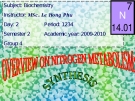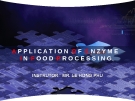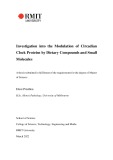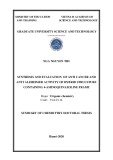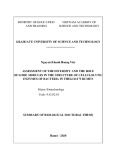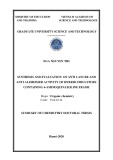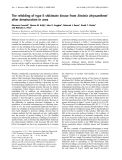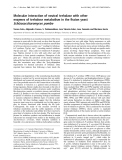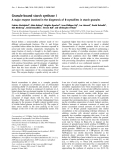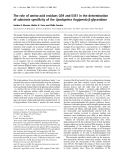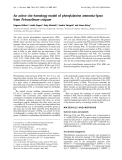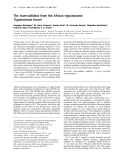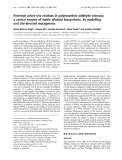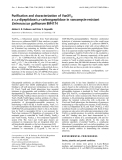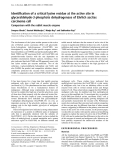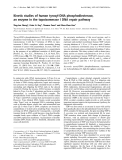
Enzyme structure
-
A reaction happens need the energy to vibrate the molecules and the reactant concentration enough. The energy here is often provided by heat. However, in living system, high temperature may harm the biological structure Truly that the concentration in living system is very low. So living organisms solve these problems by using enzyme
 94p
94p  zingzing09
zingzing09
 21-10-2012
21-10-2012
 69
69
 10
10
 Download
Download
-
- Polysaccharides are macromolecules, polymers with a few hundred to a few thousand monosaccharides joined by glycosidic linkages. - Some polysaccharides serve as storage material, hydrolyzed as needed to provide sugar for cells. - Other polysaccharides serve as building material for structures that protect the cell or the whole organism. - The architecture and function of a polysaccharide are determined by its sugar monomers and by the positions of its glycosidic linkages.
 118p
118p  zingzing09
zingzing09
 21-10-2012
21-10-2012
 56
56
 9
9
 Download
Download
-
Refers to a natural process converting atmospheric nitrogen to ammonium to yield usable nitrogen source. • Only a few prokaryotic species can "fix" nitrogen. • Nitrogenase complex dinitrogenase dinitrogenase reductase
 114p
114p  zingzing09
zingzing09
 21-10-2012
21-10-2012
 94
94
 8
8
 Download
Download
-
Alter the appearance, aroma, texture and flavor of a product. Deliver nutrients more effectively to the body or to make a food that is difficult to digest a bit easier to swallow. Accelerate the good fermentation time, giving a finished product in weeks instead of months.
 36p
36p  zingzing09
zingzing09
 21-10-2012
21-10-2012
 105
105
 19
19
 Download
Download
-
Many enzymes are added to grain feeds in order to convert some of the indigestible carbohydrates acting only as dietary fiber to accessible energy sources. amylases and glycases
 24p
24p  zingzing09
zingzing09
 21-10-2012
21-10-2012
 88
88
 10
10
 Download
Download
-
Master's thesis of Science "Investigation into the modulation of circadian clock proteins by dietary compounds and small molecules" is structured as follows: Chapter 1 Introduction; Chapter 2 Identification of novel bioactive compounds from Olea europaea by evaluation of chemical compounds in the OliveNetTM library: in silico bioactivity and molecular modelling, and in vitro validation of hERG activity; Chapter 3 Modulation of circadian core clock proteins by dietary compounds; Chapter 4 Molecular mechanisms of action of selected olive phenolics against epigenetic modifiers and the structur...
 235p
235p  runthenight04
runthenight04
 02-02-2023
02-02-2023
 8
8
 3
3
 Download
Download
-
Objectives of the dissertation: Research and synthesize and determine the hybrid compound structure containing Quinazoline frame. Research on carcinogenic activity and inhibition of acetylcholinesterase enzyme of synthetic compounds..
 26p
26p  extraenglish
extraenglish
 24-05-2021
24-05-2021
 23
23
 3
3
 Download
Download
-
Analyzing the diversity of cellulases and modular cellulases of microbial community in rumen goat by Metagenomics; analyzing the diversity of cellulases and modular cellulases of microbial community in rumen goat by Metagenomics.
 26p
26p  capheviahe27
capheviahe27
 23-02-2021
23-02-2021
 18
18
 5
5
 Download
Download
-
Synthesis and structural determination of some 4-aminoquinazoline derivatives containing prop-2-yn-1-yloxy substituents at C-6 position; research and synthesize and determine the hybrid compound structure containing Quinazoline frame; research on carcinogenic activity and inhibition of acetylcholinesterase enzyme of synthetic compounds; studying protein docking and predicting the pharmacokinetic properties of some compounds that inhibit the enzyme acetylcholinesterase.
 26p
26p  capheviahe27
capheviahe27
 23-02-2021
23-02-2021
 42
42
 4
4
 Download
Download
-
Shikimate kinase was chosen as a convenient representative example of the subclass of a/b proteins with which to examine the mechanism of protein folding. In this paper we report on the refolding of the enzyme after denaturation in urea. As shown by the changes in secondary and tertiary structure monitored by far UV circular dichroism (CD) and fluorescence, respectively, the enzyme was fully unfolded in 4 M urea. From an analysis of the unfolding curve in terms of the two-state model, the stability of the folded state could be estimated as 17 kJÆmol)1.
 9p
9p  system191
system191
 01-06-2013
01-06-2013
 49
49
 5
5
 Download
Download
-
Trehalose metabolism is an essential component of the stress response in yeast cells. In this work we show that the products of the principal genes involved in trehalose metabolism in Schizosaccharomyces pombe, tps1+ (coding for trehalose6-P synthase, Tps1p), ntp1+ (encoding neutral trehalase, Ntp1p) and tpp1+ (that codes for trehalose-6-P phosphatase, Tpp1p), interact in vitro with each other and with themselves to form protein complexes. Disruption of the gene tps1+ blocks the activation of the neutral trehalase induced by heat shock but not by osmotic stress.
 9p
9p  system191
system191
 01-06-2013
01-06-2013
 29
29
 4
4
 Download
Download
-
Starch defines a semicrystalline polymer made of two different polysaccharide fractions. The A- and B-type crystalline lattices define the distinct structures reported in cereal and tuber starches, respectively. Amylopectin, the major fraction of starch, is thought to be chiefly responsible for this semicrystalline organization while amylose is generally considered as an amorphous polymer with little or no impact on the overall crystalline organization.
 11p
11p  system191
system191
 01-06-2013
01-06-2013
 47
47
 4
4
 Download
Download
-
The design of b-glycosidases with planed substrate specificity for biotechnological application has received little attention. This is mostly a consequence of the lack of data on the molecular basis of the b-glycosidase specificity, namely data on the energy of the noncovalent interactions in the enzymetransition state complex. In an attempt to fill this gap, sitedirected mutagenesis and enzyme steady-state kinetic experiments with different substrates were conducted, using as model a digestive b-glycosidase (glycoside hydrolase family 1) from Spodoptera frugiperda (Lepidoptera) (Sfbgly50).
 10p
10p  system191
system191
 01-06-2013
01-06-2013
 48
48
 4
4
 Download
Download
-
The plant enzyme phenylalanine ammonia-lyase (PAL, EC 4.3.1.5) shows homology to histidine ammonia-lyase (HAL) whose structure has been solved by X-ray crystallography. Based on amino-acid sequence alignment of the two enzymes, mutagenesis was performed on amino-acid residues that were identical or similar to the active site residues in HAL to gain insight into the importance of this residues in PAL for substrate binding or catalysis. We mutated the following amino-acid residues: S203, R354, Y110, Y351, N260, Q348, F400, Q488 and L138....
 11p
11p  system191
system191
 01-06-2013
01-06-2013
 69
69
 4
4
 Download
Download
-
Trypanosoma brucei is the cause of the diseases known as sleeping sickness in humans (T. brucei ssp. gambiense and ssp. rhodesiense) and ngana in domestic animals (T. brucei brucei) in Africa. Procyclic trypomastigotes, the tsetse vector stage, express a surface-bound trans-sialidase that transfers sialic acid to the glycosylphosphatidylinositol anchor of procyclin, a surface glycoprotein covering the parasite surface. Trans-sialidase is a unique enzyme expressed by a few trypanosomatids that allows them to scavenge sialic acid from sialylated compounds present in the infected host. ...
 10p
10p  system191
system191
 01-06-2013
01-06-2013
 49
49
 4
4
 Download
Download
-
In the biosynthesis of the antiarrhythmic alkaloid ajmaline, polyneuridine aldehyde esterase (PNAE) catalyses a central reaction by transforming polyneuridine aldehyde into epivellosimine, which is the immediate precursor for the synthesis of the ajmalane skeleton. The PNAE cDNA was previously heterologously expressed in E. coli. Sequence alignments indicated that PNAE has a 43% identity to a hydroxynitrile lyase from Hevea brasiliensis, which is a member of the a/b hydrolase superfamily. The catalytic triad, which is typical for this family, is conserved.
 8p
8p  system191
system191
 01-06-2013
01-06-2013
 36
36
 4
4
 Download
Download
-
VanXYC, a bifunctional enzyme from VanC-phenotype Enterococcus gallinarum BM4174 that catalyses D,D-peptidase and D,D-carboxypeptidase activities, was purified as the native protein, as a maltose-binding protein fusion and with an N-terminal tag containing six histidine residues. The kinetic parameters of His6–VanXYC were measured for a variety of precursors of peptidoglycan synthesis involved in resistance: for D-Ala-D-Ala, the Km was 3.6 mM and kcat, 2.5 s)1; for UDP-MurNAc-L-Ala-D-Glu-L-Lys-D-Ala-DAla (UDP-MurNAc-pentapeptide[Ala]), Km was 18.8 mM and kcat 6.
 7p
7p  system191
system191
 01-06-2013
01-06-2013
 43
43
 4
4
 Download
Download
-
The involvement of the lysine residue present at the active site of Ehrlich ascites carcinoma (EAC) cell glyceraldehyde-3-phosphate dehydrogenase (Gra3P DH) was investigated by using the lysine specific reagents trinitrobenzenesulfonic acid (TNBS) and pyridoxal phosphate (PP). Both TNBS and PP inactivated EAC cell Gra3P DH with pseudo-first-order kinetics with the rate dependent on modifier concentration. Kinetic analysis, including a Tsou plot, indicated that both TNBS and PP apparently react with one lysine residue per enzyme molecule.
 8p
8p  system191
system191
 01-06-2013
01-06-2013
 38
38
 3
3
 Download
Download
-
Tyrosyl-DNA phosphodiesterase (TDP) cleaves the phosphodiester bond linking the active site tyrosine residue of topoisomerase I with the 3¢ terminus of DNA in topoisomerase I–DNA complexes which accumulate during treatment of cancer with camptothecin. In yeast, TDP mutation confers a 1000-fold hypersensitivity to camptothecin in the presence of an additional mutation of RAD9 gene [Pouliot, J.J., Yao, K.C., Robertson, C.A. & Nash, H.A. (1999) Science 286, 552–555].
 8p
8p  research12
research12
 01-06-2013
01-06-2013
 43
43
 3
3
 Download
Download
-
A clone encoding farnesyl diphosphate synthase (FPPS) was obtained by PCR from a cDNA library made from young leaves of Artemisia annua. A cDNA clone encoding the tobacco epi-aristolochene synthase (eAS) was kindly supplied by J. Chappell (University of Kentucky, Lexington, KY, USA). Two fusions were constructed, i.e. FPPS/ eAS and eAS/FPPS. The stop codon of the N-terminal enzyme was removed and replaced by a short peptide (Gly-SerGly) to introduce a linker between the two ORFs.
 8p
8p  research12
research12
 01-06-2013
01-06-2013
 39
39
 3
3
 Download
Download
CHỦ ĐỀ BẠN MUỐN TÌM










